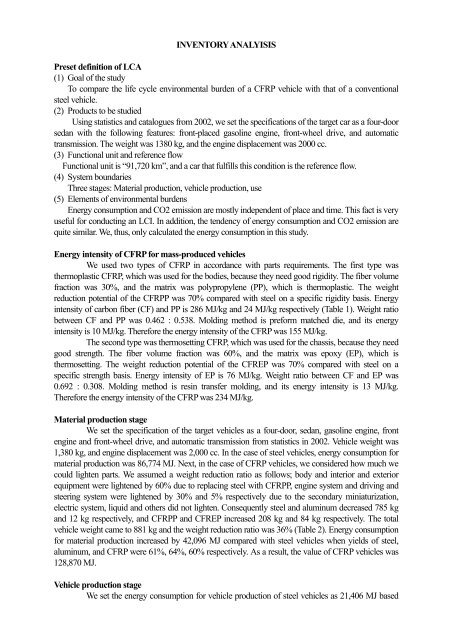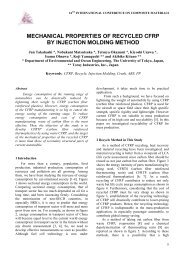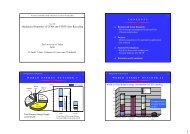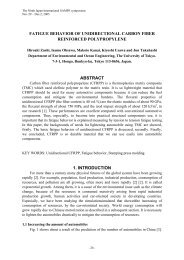lca of lightweight vehicles by using cfrp for mass ... - Takahashi
lca of lightweight vehicles by using cfrp for mass ... - Takahashi
lca of lightweight vehicles by using cfrp for mass ... - Takahashi
Create successful ePaper yourself
Turn your PDF publications into a flip-book with our unique Google optimized e-Paper software.
INVENTORY ANALYISISPreset definition <strong>of</strong> LCA(1) Goal <strong>of</strong> the studyTo compare the life cycle environmental burden <strong>of</strong> a CFRP vehicle with that <strong>of</strong> a conventionalsteel vehicle.(2) Products to be studiedUsing statistics and catalogues from 2002, we set the specifications <strong>of</strong> the target car as a four-doorsedan with the following features: front-placed gasoline engine, front-wheel drive, and automatictransmission. The weight was 1380 kg, and the engine displacement was 2000 cc.(3) Functional unit and reference flowFunctional unit is “91,720 km”, and a car that fulfills this condition is the reference flow.(4) System boundariesThree stages: Material production, vehicle production, use(5) Elements <strong>of</strong> environmental burdensEnergy consumption and CO2 emission are mostly independent <strong>of</strong> place and time. This fact is veryuseful <strong>for</strong> conducting an LCI. In addition, the tendency <strong>of</strong> energy consumption and CO2 emission arequite similar. We, thus, only calculated the energy consumption in this study.Energy intensity <strong>of</strong> CFRP <strong>for</strong> <strong>mass</strong>-produced <strong>vehicles</strong>We used two types <strong>of</strong> CFRP in accordance with parts requirements. The first type wasthermoplastic CFRP, which was used <strong>for</strong> the bodies, because they need good rigidity. The fiber volumefraction was 30%, and the matrix was polypropylene (PP), which is thermoplastic. The weightreduction potential <strong>of</strong> the CFRPP was 70% compared with steel on a specific rigidity basis. Energyintensity <strong>of</strong> carbon fiber (CF) and PP is 286 MJ/kg and 24 MJ/kg respectively (Table 1). Weight ratiobetween CF and PP was 0.462 : 0.538. Molding method is pre<strong>for</strong>m matched die, and its energyintensity is 10 MJ/kg. There<strong>for</strong>e the energy intensity <strong>of</strong> the CFRP was 155 MJ/kg.The second type was thermosetting CFRP, which was used <strong>for</strong> the chassis, because they needgood strength. The fiber volume fraction was 60%, and the matrix was epoxy (EP), which isthermosetting. The weight reduction potential <strong>of</strong> the CFREP was 70% compared with steel on aspecific strength basis. Energy intensity <strong>of</strong> EP is 76 MJ/kg. Weight ratio between CF and EP was0.692 : 0.308. Molding method is resin transfer molding, and its energy intensity is 13 MJ/kg.There<strong>for</strong>e the energy intensity <strong>of</strong> the CFRP was 234 MJ/kg.Material production stageWe set the specification <strong>of</strong> the target <strong>vehicles</strong> as a four-door, sedan, gasoline engine, frontengine and front-wheel drive, and automatic transmission from statistics in 2002. Vehicle weight was1,380 kg, and engine displacement was 2,000 cc. In the case <strong>of</strong> steel <strong>vehicles</strong>, energy consumption <strong>for</strong>material production was 86,774 MJ. Next, in the case <strong>of</strong> CFRP <strong>vehicles</strong>, we considered how much wecould lighten parts. We assumed a weight reduction ratio as follows; body and interior and exteriorequipment were lightened <strong>by</strong> 60% due to replacing steel with CFRPP, engine system and driving andsteering system were lightened <strong>by</strong> 30% and 5% respectively due to the secondary miniaturization,electric system, liquid and others did not lighten. Consequently steel and aluminum decreased 785 kgand 12 kg respectively, and CFRPP and CFREP increased 208 kg and 84 kg respectively. The totalvehicle weight came to 881 kg and the weight reduction ratio was 36% (Table 2). Energy consumption<strong>for</strong> material production increased <strong>by</strong> 42,096 MJ compared with steel <strong>vehicles</strong> when yields <strong>of</strong> steel,aluminum, and CFRP were 61%, 64%, 60% respectively. As a result, the value <strong>of</strong> CFRP <strong>vehicles</strong> was128,870 MJ.Vehicle production stageWe set the energy consumption <strong>for</strong> vehicle production <strong>of</strong> steel <strong>vehicles</strong> as 21,406 MJ based







